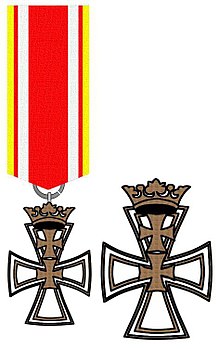Gdansk cross

The Danzig Cross was born on 31 August 1939 by the short term as head of state of the Free City of Danzig incumbent Gauleiter Albert Forster donated and for contribution to the development of the Nazi Party in the district of Danzig and the National Socialist state Danzig as well as for building the defense of Danzig before 31 Awarded August 1939. Awards mainly took place on the traditional day of the Danzig National Socialists, October 24, 1939. As a state award, the Danzig Cross was on an equal footing with the awards of other German states from May 1, 1941. The notification from the Presidential Chancellery of the Ordenskanzlei read as follows:
“In response to multiple inquiries regarding the way of wearing the Danzig Cross, the following is communicated in agreement with the High Command of the Wehrmacht: The Danzig Cross is a state award of the National Socialist State of Danzig, which was dated August 31, 1939, the day before the unification with the Greater German Reich, founded by the head of state of the Free City of Danzig, Gauleiter Forster. The Cross of Danzig is thus a state award that is equal to the awards of the other German states. The 2nd class of the award is to be worn on the medal buckle in the row of medals and decorations of former German sovereigns. "
Appearance and wearing style
The award is one of bronze -made gilded white enameled Tatzenkreuz with double golden decorative lines on the cross arms. On top of the decoration are two small crosses, which are surmounted by a crown. The arrangement corresponds to the illustration in the coat of arms of the Free City of Danzig . The back of both classes is smooth and golden. The award always took place in a red case, on the lid of which the coat of arms of the city of Danzig was embossed in gold. The design of the honorary mark comes from the master stage set master Benno von Arent .
1st Class
On the back of the Danzig Cross 1st class there is a massive pin, which was hung on a roller hinge. The whole thing got hold by a simple hook on the underside. The dimensions were approximately 61 mm × 42.5 mm. The 1st class was worn as a cross on the left breast pocket of the recipient under the other awards of the Reich, as it was a state award.
2nd Class
The 2nd class Danzig Cross was slightly smaller than that of the 1st class and was 47.5 mm × 35 mm in size. At the top of the crown, as is usual with all ribbon orders, there was a transverse eyelet with a ribbon ring. The 2nd class was only worn as a ribbon on the interim clasp after the day it was awarded. This did not apply to festive occasions or state acts, where wearing the large medal buckle was expressly permitted. Here, too, the ribbon itself was always worn behind the awards of the German Reich and as a national award, parallel to the first class regulation.
Award numbers
The relevant literature on this subject assumes 88 first-class awards and 253 second-class awards. However, this is incorrect as these figures only refer to the reference date December 11, 1939 (the last day of the award period). In fact, the Danzig Cross was awarded in individual cases until the end of 1940. However, it is not possible to determine exact details.
Known porters
I. class
- Hermann Göring (1st award)
- Ludolf-Hermann von Alvensleben
- Benno von Arent (architect)
- Erich von dem Bach-Zelewski
- Hans Frank
- Joseph Goebbels
- Max Halbe
- Reinhard Heydrich
- Erich Hilgenfeldt
- Kurt Hoffmann (Danzig) (1889–1945), General Director of the Danzig Port Company
- Karl Sigismund Litzmann
- Joachim von Ribbentrop
- Franz Xaver Schwarz
- Max Simon
- Theodor Eicke
- Fritz Todt
- Heinrich Klose (surgeon)
- Viktor Boettcher
- Hans Fuchs (doctor)
II class
- Arthur Seyss-Inquart
- Hans Baur (pilot)
- Kurt Daluege
- Julius Schaub
- John Pauls
- Harry Siegmund Expression not used
as well as the majority of the commanders of the SS Heimwehr Danzig
Others
It should be noted that the Danzig Cross was little or no known in the German Empire. Neither in the numerous party announcements nor in other publications of the time are there any references to the creation of this award. Only the marine ordinance sheet of May 1, 1941 briefly describes how they are worn. It is also responsible for the “unpopularity” of this award that the influential personalities (e.g. Göring or Heydrich) did not even wear the cross themselves.
Individual evidence
- ^ Uniform market of May 1, 1941
literature
- Jörg Nimmergut : German medals and decorations until 1945. Volume 4. Württemberg II - German Empire. Central Office for Scientific Order Studies, Munich 2001, ISBN 3-00-001396-2 .
